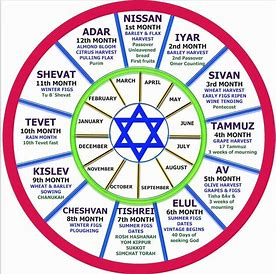Hebrew Calendar
The Hebrew
calendar (Hebrew: הַלּוּחַ הָעִבְרִי, romanized: HaLuah HaIvri), also called
the Jewish calendar, is a lunisolar calendar used
today for Jewish religious observance and as an official calendar
of Israel. It determines the dates of Jewish holidays and other rituals, such as yahrzeits and the schedule of public Torah readings. In
Israel, it is used for religious purposes, provides a time frame for
agriculture, and is an official calendar for civil holidays alongside the Gregorian calendar.
Like other
lunisolar calendars, the Hebrew calendar consists of months of 29 or 30 days
which begin and end at the time of the new moon. As 12 such months comprise a total of just 354 days,
an extra lunar month is
added every 2 or 3 years so that the long-term average year length closely
approximates the actual length of the solar year.
Originally, the
beginning of each month was determined based on physical observation of a new
moon, while the decision of whether to add the leap month was based on
observation of natural agriculture-related events in ancient Israel. Between
the years 70 and 1178, these the Rabbi’s established a set of mathematical
rules. Month length now follows a fixed schedule which is adjusted based on
the interval (a mathematical approximation of the mean time
between new moons) and several other rules, while leap months are now added in 7 out
of every 19 years according to the Metonic cycle.
Nowadays, Hebrew
years are generally counted according to the system of Anno Mundi (Latin:
"in the year of the world"; Hebrew: לבריאת העולם,
"from the creation of the world", abbreviated AM). This system
attempts to calculate the number of years since the creation of the world,
according to the Genesis creation narrative and
subsequent Biblical stories. The current Hebrew year, AM 5784, began at sunset
on 15 September 2023 and will end at sunset on 2 October 2024.




Comments
Post a Comment